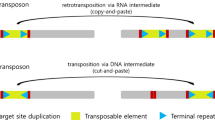Abstract.
Transposons are ubiquitous mobile genetic elements found in all eu- and prokaryotic cells. The first transposon identified, the maize Activator element, belongs to the hAT family. hAT transposons have been identified in most eukaryotic lineages, including plants, fungi, animals and even man. The basic structural and functional features of this transposon family and its phylogenetic roots are discussed in detail, including a phylogenetic tree deduced from the amino acid sequence of the most conserved part of the transposon-encoded transposase. Emphasis is given to the use of hAT transposons as tools for gene tagging and insect transformation as well as to their biological function, i.e. are they selfish DNA, beneficial companions, or even both?
Similar content being viewed by others
Author information
Authors and Affiliations
Additional information
In revised form: 18 September 2000
Electronic Publication
Rights and permissions
About this article
Cite this article
Kempken, F., Windhofer, F. The hAT family: a versatile transposon group common to plants, fungi, animals, and man. Chromosoma 110, 1–9 (2001). https://doi.org/10.1007/s004120000118
Received:
Accepted:
Issue Date:
DOI: https://doi.org/10.1007/s004120000118




